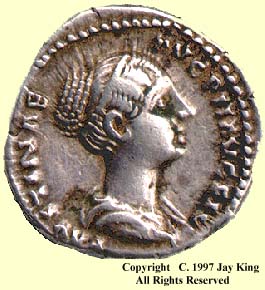 Contents -
Previous Article -
Next Article
Contents -
Previous Article -
Next Article
Faustina the Younger was the daughter of the emperor Antoninus Pius and his wife Faustina the Elder. She was married to Marcus Aurelius in A. D. 145 before he became a Roman emperor. We do not have a great deal of primary source material on her life, but the evidence we do have suggests that the couple was very close. They were blessed with an abundance of children, amongst whom were the future emperor Commodus and the future empress Lucilla. Faustina accompanied her emperor husband during his numerous campaigns in the field, attempting to make a home out of an army camp. She was loved and revered by the Roman soldiers, who called her Matri Castrorum, or, "Mother of the Camp". The years spent on military campaigns at the side of her husband began to take their toll. Faustina the Younger died at the village of Halala in faraway Cappadocia in A. D. 176. She was only forty six years old. Some of the most beautiful portraits of contemporary Roman women are those found on the coins of Faustina the Younger. Realistic portraiture on Roman coins probably reached its high point during the Second Century and it is this author's opinion that the most lovely are found on coins beginning with Faustina the Elder through the early issues of Julia Domna. During the First Century, the female portraits on coins closely resembled the standard, stylized portraits of goddesses in the Roman and Greek pantheon. After about A. D. 200, the portraits assumed a very regal style, probably symbolic of the lady's exalted position as wife of an emperor and a god. During the early years, the Roman aristocracy frowned upon depiction of actual persons on coinage, deeming it a symbol of royalty. Though they were in fact ruled by an emperor, he was polite enough to refer to himself as "First Citizen" rather than DOMINI or "Lord". Theis keeping up of the appearance of having a republic was more pleasing to the Senate than the wielding of naked power that came later. After the civil wars following the death of Commodus, it became more and more obvious that the Senate no longer had even a tiny shred of the power it once held and the emperors openly acknowledged their position of supreme power. Part of this was the standardization of certain portrait features, especially the hair styles of the women. By the time of the economic reform under Diocletian, the portraits were so standardized that one couldn't tell one emperor from the other by their portraits. The female portraits had become stiffly symbolic and the style was very monotonous, having lost almost all of its vitality. Exceptions to this trend do exist and there are some exquisitely beautiful portraits from later years, but most are quite rare and bring a huge sum when sold at auction.
Go to next article: on Lucilla
Go back to previous article: on Faustina the Elder